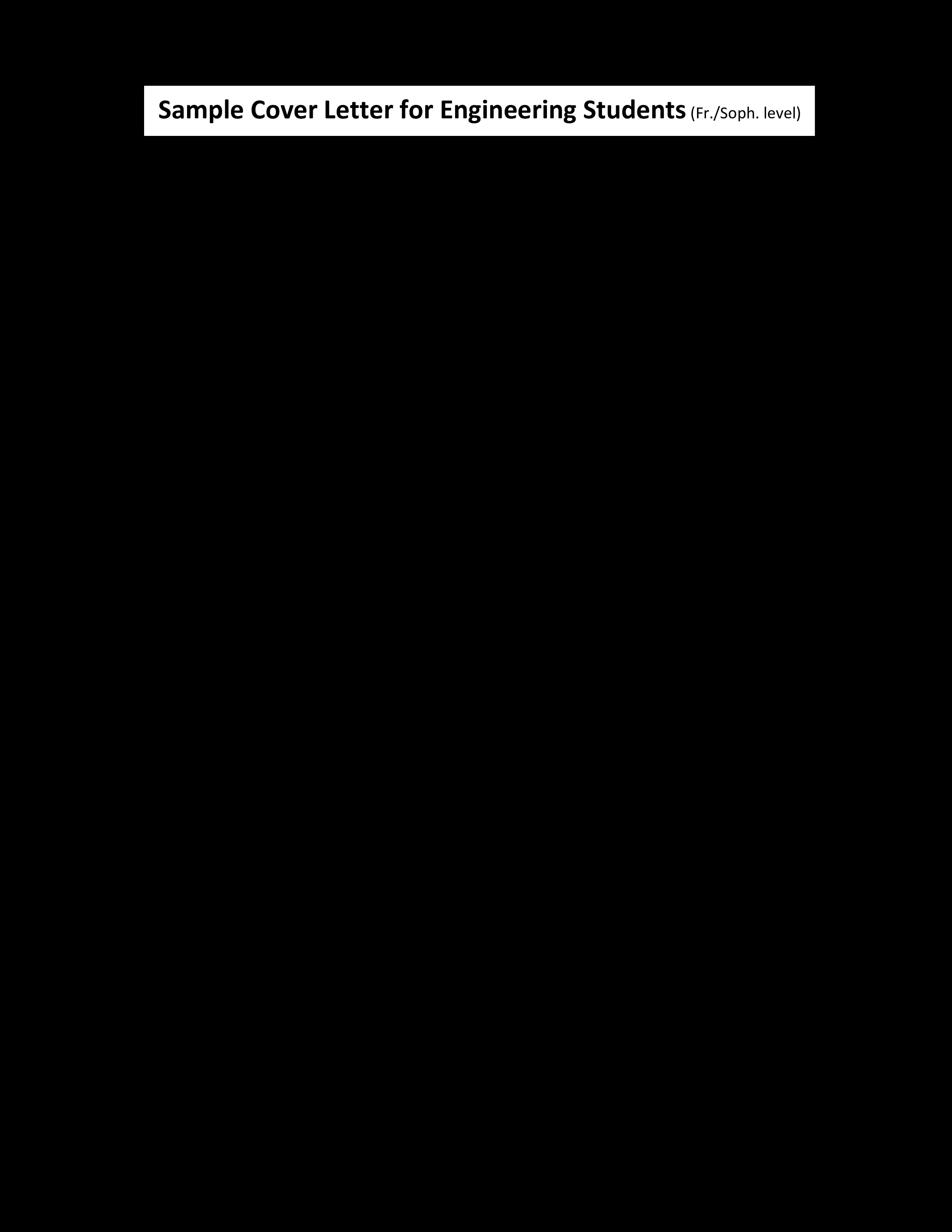What is an Engineering Internship Cover Letter?
An engineering internship cover letter is a crucial document that accompanies your resume when applying for an internship position in the field of engineering. It serves as your introduction to the hiring manager or recruiter, providing an opportunity to showcase your enthusiasm, qualifications, and suitability for the role. This letter is your chance to make a strong first impression and persuade the employer to consider your application seriously. Unlike a resume, which provides a factual overview of your skills and experiences, a cover letter allows you to express your personality, explain your motivations, and connect your qualifications to the specific requirements of the internship.
Why is a Cover Letter Important for Engineering Internships?
A well-crafted cover letter is essential for several reasons. Firstly, it demonstrates your genuine interest in the internship and the company. It shows that you’ve taken the time to research the organization and understand the position. Secondly, a cover letter allows you to highlight the specific skills and experiences that make you a strong candidate, aligning them with the requirements outlined in the job description. This is where you can go beyond a list of accomplishments and explain how your skills translate into real-world value for the company. Thirdly, a cover letter provides an opportunity to address any gaps or weaknesses in your resume, such as a lack of direct experience. Finally, it gives you a chance to showcase your writing and communication skills, which are critical for any engineering role.
Key Components of a Stellar Cover Letter
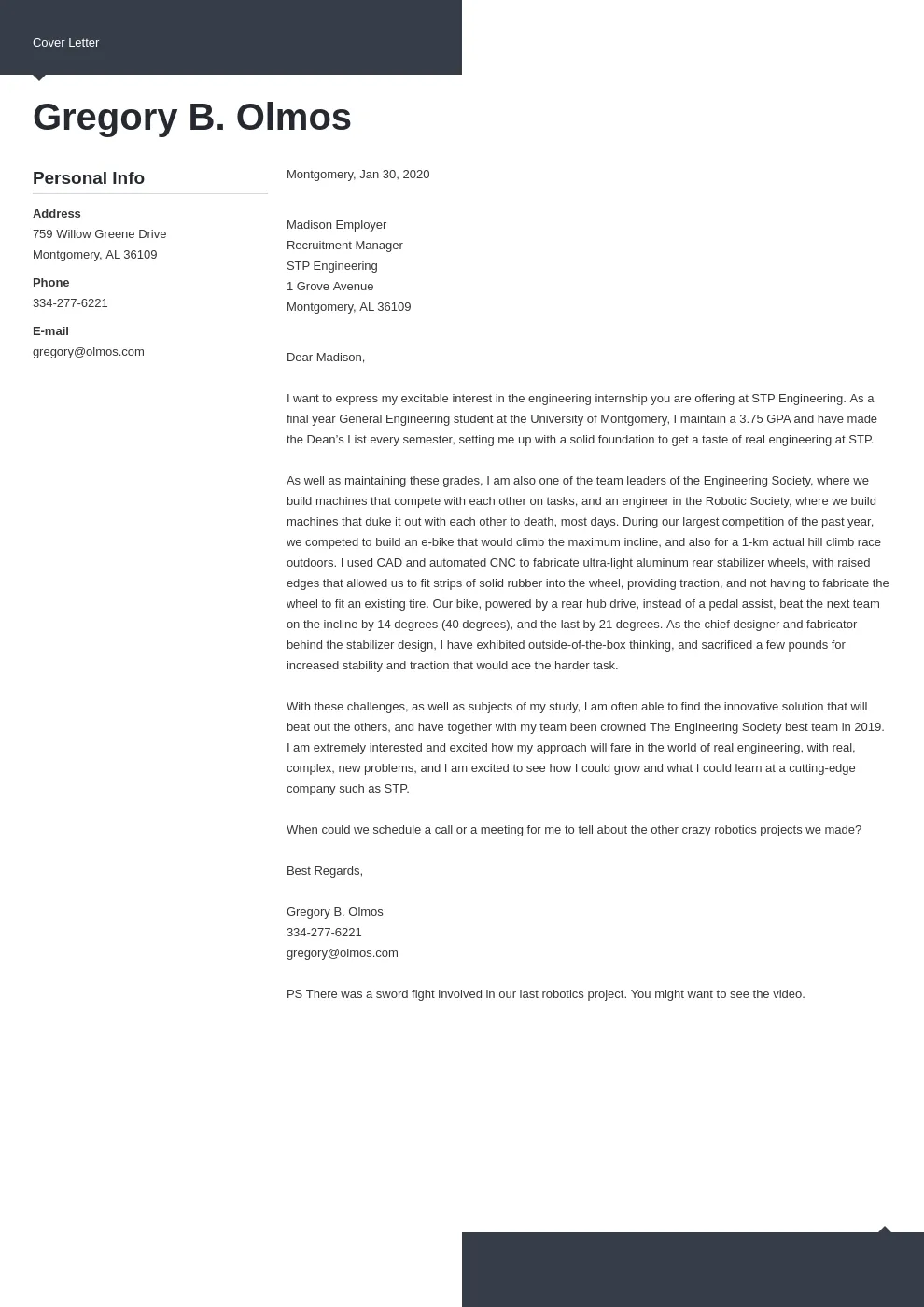
A successful cover letter follows a standard format, yet it’s how you fill it that matters. Several key elements contribute to a stellar cover letter that grabs the reader’s attention and compels them to learn more about you. Focusing on these components ensures your application shines in a sea of applicants. Each section serves a specific purpose in presenting you as the ideal candidate for the internship. These building blocks work together to create a compelling narrative that showcases your unique strengths and aspirations.
Your Contact Information and Date
At the top of your cover letter, include your full name, address, phone number, and email address. This ensures that the hiring manager can easily contact you. Below your contact information, add the date you are submitting the letter. This information is crucial for easy reference and organization.
The Recipient’s Information
Address your cover letter to a specific person, if possible. Research the name and title of the hiring manager or the person in charge of recruiting interns. This personalized approach shows that you’ve put in the effort to learn about the company and the internship. If you can’t find a specific name, use a professional salutation such as “Dear Hiring Manager”.
A Strong Opening Hook
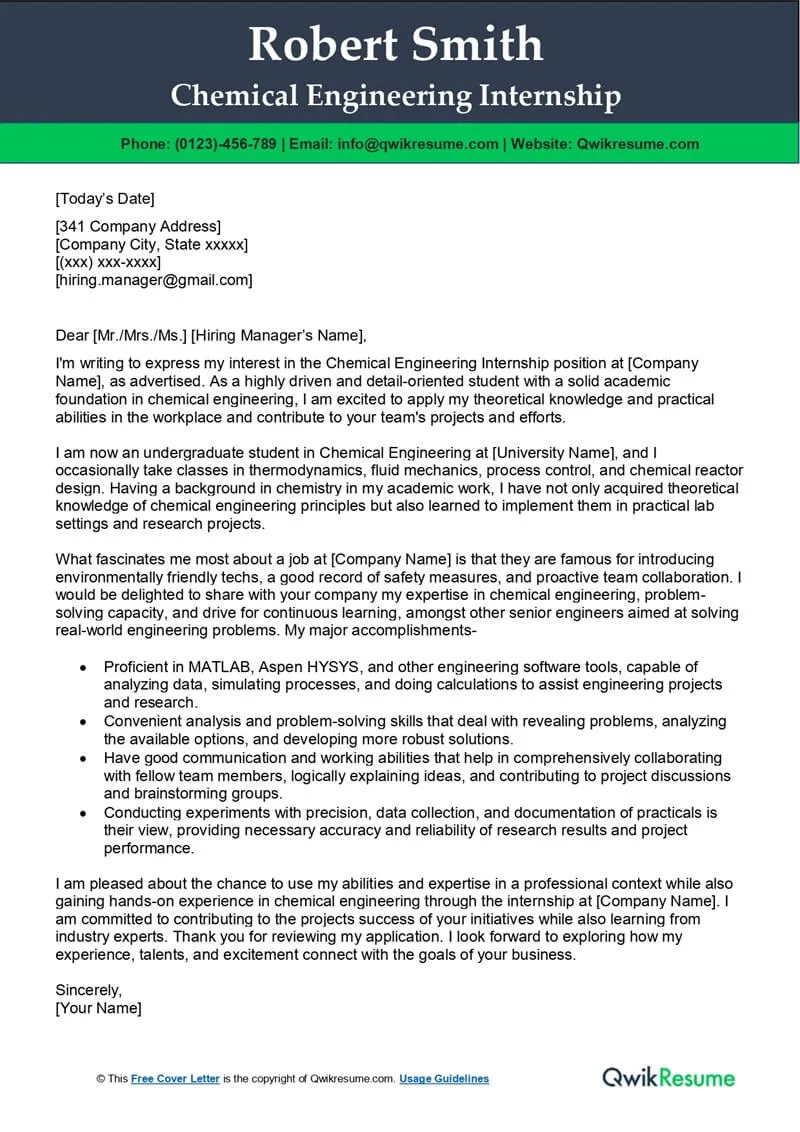
Your opening paragraph is your chance to grab the reader’s attention. Start with a compelling statement that highlights your enthusiasm for the internship and the company. Mention where you saw the job posting and briefly state why you’re interested in the position. This initial hook should be concise and directly convey your intent.
Highlighting Your Skills and Qualifications
In the body of your cover letter, discuss your relevant skills and qualifications. Use specific examples from your coursework, projects, or previous experiences to demonstrate how you meet the requirements of the internship. Tailor your letter to match the job description and highlight the skills that the employer is seeking. This is your chance to show the hiring manager what sets you apart from other candidates.
Showcasing Relevant Projects and Experiences
Describe projects or experiences that demonstrate your technical abilities and problem-solving skills. Explain your role in these projects, the challenges you faced, and the solutions you developed. Mention specific software, tools, or technologies you’re proficient in. This section allows you to provide context and depth to your resume.
Quantifying Your Achievements
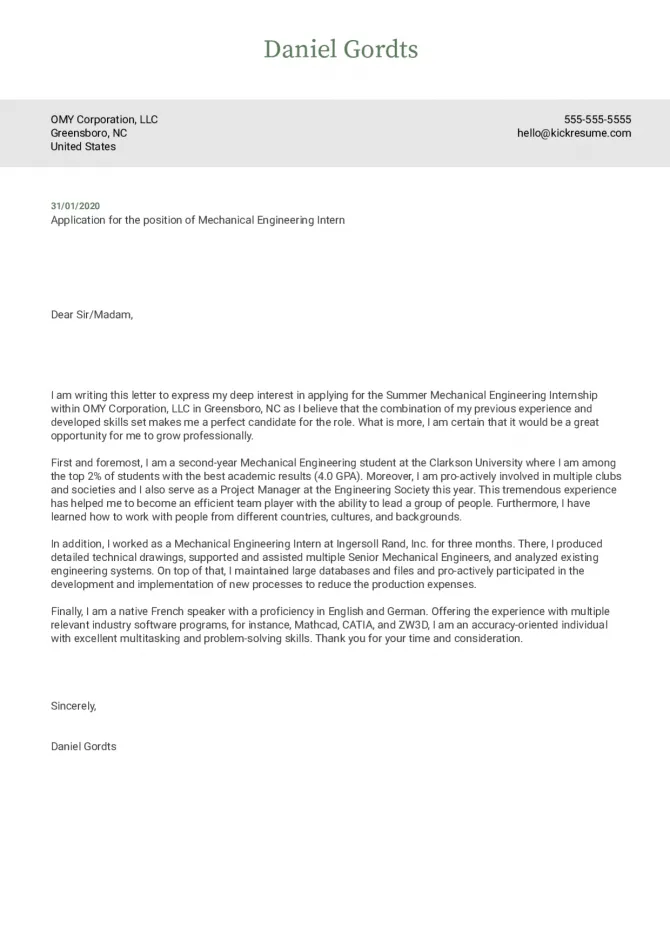
Whenever possible, quantify your achievements with numbers and data. For example, instead of saying “Improved the efficiency of a process,” say “Improved the efficiency of the process by 15%.” Use metrics to demonstrate the impact of your contributions. This provides tangible evidence of your skills and capabilities.
Expressing Enthusiasm and Interest
Show genuine enthusiasm for the internship and the company. Explain what specifically interests you about the role and why you want to work there. Show that you’ve researched the company’s mission, values, and recent projects. This enthusiasm can make a strong positive impression.
Mentioning Company Values
If you know about the company’s core values, mention how your values align with theirs. This shows that you are a good fit for the company culture and are likely to thrive in the internship. It demonstrates that you have taken the time to learn about the organization beyond the job description.
Proper Closing and Call to Action
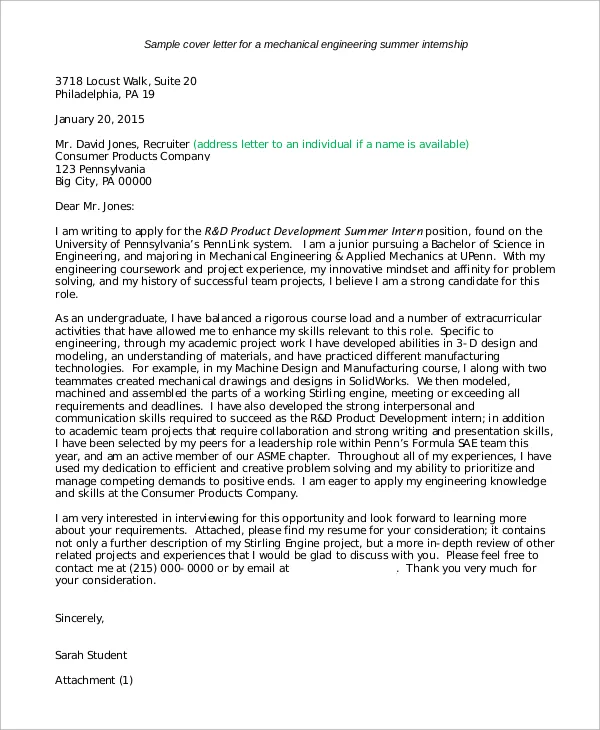
End your cover letter with a strong closing paragraph that reiterates your interest in the internship and expresses your eagerness to discuss your qualifications further. Include a call to action, such as “I am eager to discuss my qualifications further in an interview.” Thank the hiring manager for their time and consideration. Use a professional closing, such as “Sincerely” or “Best regards,” followed by your name.
Proofreading and Formatting
Before submitting your cover letter, carefully proofread it for any errors in grammar, spelling, and punctuation. A polished cover letter demonstrates attention to detail, which is essential in engineering. Ensure that the formatting is consistent and easy to read. Use a professional font and clear spacing. Consider using bullet points or lists to organize your information and make it more readable. Have a friend or career advisor review your letter for any potential issues.
Common Mistakes to Avoid
Avoiding common mistakes can greatly improve your chances of getting an interview. Being mindful of these pitfalls will help you present yourself as a professional candidate. Often, minor errors can significantly undermine your application and reduce your likelihood of securing an interview. Being aware of what to avoid is just as important as knowing what to include.
Generic Cover Letter Templates
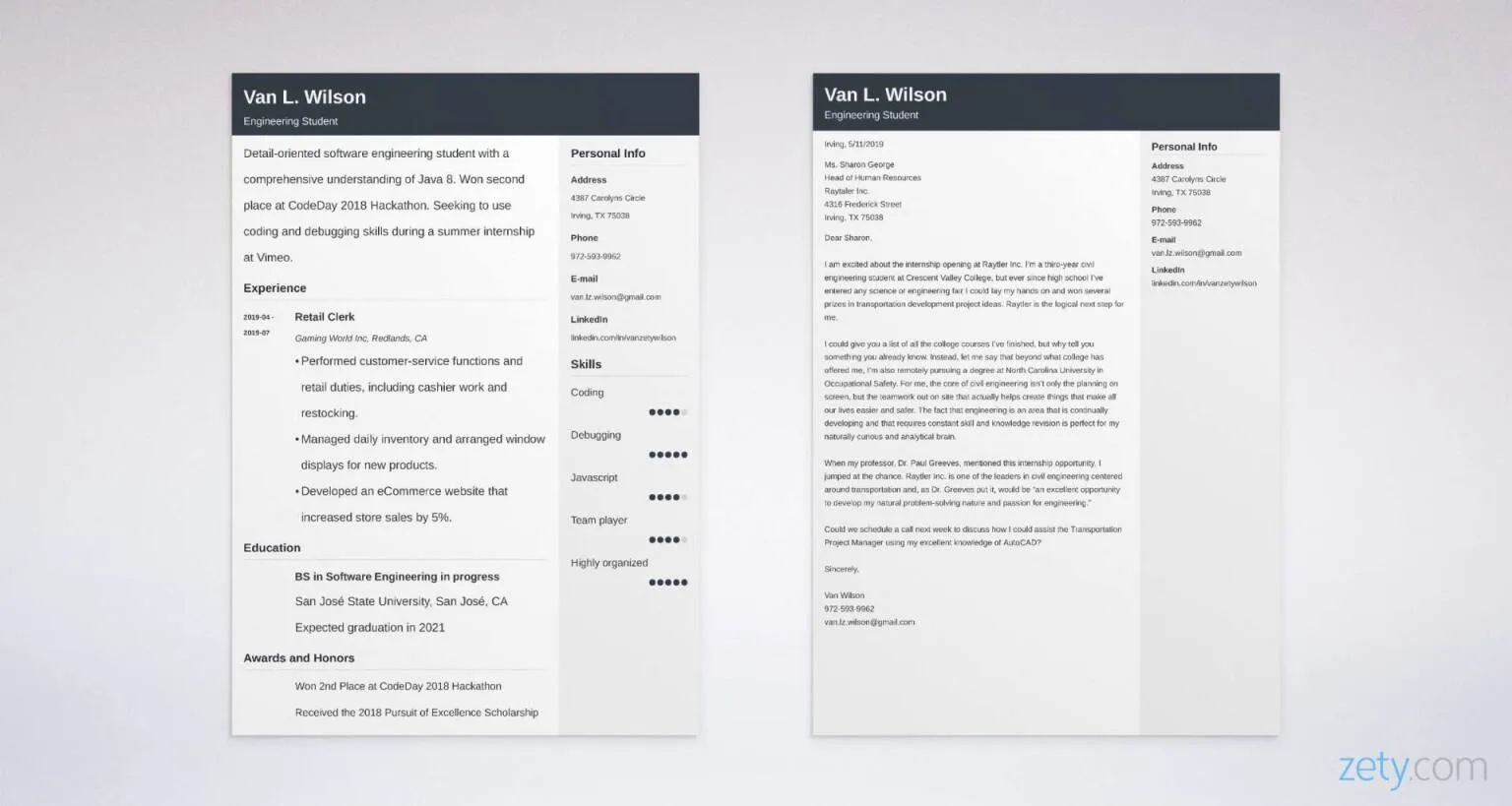
Avoid using generic cover letter templates that are not tailored to the specific internship or company. Hiring managers can easily spot a generic letter, which will make you appear uninterested. Always customize your letter to reflect the specific requirements of the role and demonstrate your genuine interest in the company.
Lack of Customization
Failing to customize your cover letter for each application is a major mistake. Tailor your letter to highlight the specific skills and experiences that align with the job description. Show that you understand the company’s needs and can contribute to their goals. Customization shows that you’ve put in the effort to research the role and the company.
Ignoring the Job Description
Carefully review the job description and address each of the requirements and qualifications listed. Highlight your skills and experiences that match the requirements. Ignoring the job description can result in your application being overlooked, as it suggests that you haven’t paid attention to the specific needs of the role.
Typos and Grammatical Errors
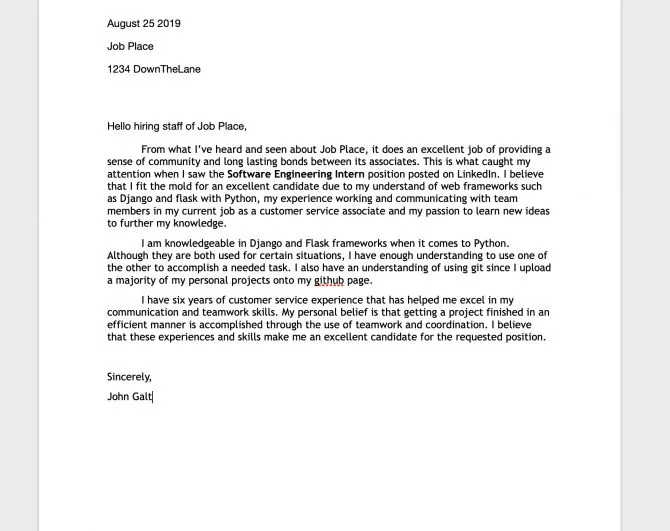
Typos and grammatical errors can damage your credibility and make you appear unprofessional. Proofread your cover letter carefully before submitting it. Use a grammar checker, and consider having a friend or career advisor review your letter for any potential mistakes. Correct grammar reflects attention to detail, a crucial quality for engineers.
Too Much or Too Little Information
Keep your cover letter concise and focused. Avoid including irrelevant information or rambling. Aim for a letter that is one page long. At the same time, ensure that you provide enough detail to showcase your qualifications and interest in the internship. Finding the right balance is crucial.
Formatting Issues
Use clear and professional formatting to make your cover letter easy to read. Choose a standard font, such as Times New Roman or Arial, and use a font size between 11 and 12 points. Use appropriate spacing between paragraphs and sections. Poor formatting can make your letter difficult to read and can distract from your message. Proper formatting helps your letter look organized and professional.
Final Review and Submission
Before submitting your cover letter, take a final look to ensure that all the details are correct. Before submitting, confirm that you have all the necessary documents. Make sure you’re submitting your resume and cover letter in a professional format, such as PDF. Double-check the email address and subject line, and then send your application.
Tailoring the Letter
Tailor your letter to the specific company and the internship role. Address the job description’s requirements and highlight how your skills align with their needs. This shows you have put in the time to understand the company and the role. Tailoring helps your application stand out.
Reviewing Before Submission
Always review your cover letter before submitting it. Proofread for any errors in grammar, spelling, and punctuation. Ensure that the formatting is consistent and that all the information is accurate. Getting a second opinion from a career advisor or friend can be beneficial. Final reviews ensure that your letter is polished and professional.
